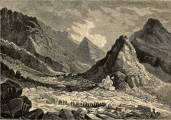


Geology
The following sections on "Economic Geology" and "Regional Geology" summarize information about the mineral deposits of Appalachia and establish the broad geologic setting which determined their distribution and habit. More detailed information about the geology of each type of deposit is given in the individual mineral commodity sections. The "Engineering Geology" section discusses geologic features that affect the works of man.
By Robert A. Laurence and George E. Ericksen,
U.S. Geological Survey
"Mineral resources, as used in this report, are the sum total of actual or potential economic deposits, which in turn are accumulations and concentrations of useful minerals and rocks. Those resources usable at any given time depend upon man's needs and the status of his technology. For example, flint was a valuable resource to the Stone Age man, whereas limestone was not; the reverse is true for modern man. Human inquiry literally creates resources by discovery of concealed deposits, by finding new ways to extract and refine raw materials that formerly could not be utilized, and by developing uses for materials formerly considered valueless.
Mineral deposits form through geologic processes, and they are limited in occurrence. They vary with the geologic setting, depending upon the history of the enclosing rocks and their composition, origin, and structure. Some minerals, diamonds for example, are rare and have special properties that make them extremely valuable. Other rare minerals that lack special uses or properties may have little value except to the collector or museum. Minerals and rocks that are commonplace, iron ore and limestone, for example, have relatively low values even though they are essential to civilization. Some mineral raw materials require little processing; others require extensive and expensive treatment before they can be used.
Igneous activity, sedimentation, metamorphism, and weathering are dominant in the formation of mineral deposits. Certain extrusive igneous rocks are of economic value, as for example, pumice, perlite, and lavas used for construction stone. Intrusive igneous rocks also may be of economic value, as are some types of granite that make beautiful decorative and building stones. Many metallic and nonmetallic deposits consist of disseminations or segregations of useful minerals in igneous intrusive rocks. Others occur as veins in the intrusive body or in nearby rocks where they were deposited by hydrothermal solutions released from within the intrusive. Mineral deposits may become exposed through erosion of the covering rocks, or they may remain concealed.
Many mineral deposits are of sedimentary origin, having been deposited along with the enclosing sedimentary rocks. The mineral fuels are excellent examples. Coal represents plant material that accumulated in swamps and marshes and subsequently was transformed during burial and compaction by younger sediments. Oil and gas also are derived from organic materials laid down during the process of sedimentation; however, they may or may not remain in the rocks in which they originally were deposited. Oil and gas can migrate easily in permeable rocks and may move considerable distances and accumulate in geologic traps to make economic deposits.
Other mineral deposits of economic value are produced by metamorphic processes which alter composition and texture of igneous and sedimentary rocks by the increase of temperature and pressure. For example, limestone metamorphoses to marble, bituminous coal to anthracite, and many types of rocks to schist and gneiss.
Weathering processes, either chemical decomposition or mechanical breakdown of minerals and rocks, also form mineral deposits. Certain types of clay form by chemical decay of the feldspars in igneous rocks. The clay may remain in place and form a residual deposit, or it may be transported by water and accumulate as a sedimentary deposit. Sulfide minerals composing most primary metal deposits are weathered and oxidized where exposed at or near the surface. The oxidized material, if it is a relatively insoluble substance such as iron oxide, may be left at the site previously occupied by the unoxidized material to form a residual deposit. Soluble materials may be leached away from the deposit, causing concentration and enrichment of the oxidized material. Solutions of high acidity, formed during weathering, may cause metal ions to a deeper part of the deposit where they are neutralized and the metals redeposited to form secondary enriched ore. A very soluble material may be carried an appreciable distance from the original source before being redeposited as a secondary deposit. Sand and gravel are products of weathering and abrasion during transport by moving water. Placer deposits of gold and other heavy minerals may form in sand and gravel by differential sorting of mineral particles by the moving water.
The Appalachian Region is geologically complex and contains a great variety of mineral resources, as shown in table 24. Each physiographic province is characterized by certain geologic features, rock types, and types of mineral deposits.. The Piedmont and Blue Ridge province are underlain principally by Precambrian and Paleozoic igneous intrusive and metamorphic rocks in which are many types of deposits. The rocks of these provinces and the adjacent Valley and Ridge province have been more deeply weathered than those of other parts of Appalachia, and therefore most of the residual deposits of Appalachia are found here. Because heavy minerals are more abundant in the Blue Ridge and Piedmont than elsewhere in Appalachia, most placer deposits are found in these provinces. The Valley and Ridge province consists of folded and faulted sedimentary rocks of Cambrian to Pennsylvanian age, in which are a wide variety of sedimentary deposits as well as low-temperature hydrothermal metalliferous deposits. The Appalachian Plateaus province is underlain by flatlying sedimentary rocks ranging from Mississippian to Permian age, characterized by extensive and very large bituminous coal resources. The small parts of western Appalachia lying within the Interior Low Plateaus and Central Lowland provinces are underlain chiefly by flat-lying sedimentary rocks of Ordovician to Mississippian age in which the principal mineral deposits are limestone, petroleum, and natural gas.
Table 24. Classification of mineral deposits of the Appalachian Region.
The mineral deposits of igneous origin (table 24) are widespread and abundant in the Piedmont and Blue Ridge provinces and some compose large or potentially large resources. Because this region is little known geologically, the distribution and importance of these resources cannot be assessed with accuracy. Nevertheless, the general distribution of the different rock types and related mineral deposits is known, and one can estimate that new deposits will be found in belts or regions where certain types of deposits are already known to exist. Thus, pegmatite and alaskite, containing abundant mica, feldspar, and lesser amounts of other minerals, are found throughout these provinces and are particularly abundant in the western Carolinas and northeastern Georgia (fig. 84, p. 316). Dunite and peridotite, containing large amounts of olivine (a refractory mineral) and lesser amounts of other mineral commodities (fig. 86, p. 326), occur in a belt extending from east-central Alabama to southwestern Virginia, and are particularly abundant in western North Carolina. (Some of these figures mentioned in this paragraph are not included on this web site.)
Of the metals in the Piedmont and Blue Ridge, copper and gold offer good potential for future large production. Copper deposits of the massive sulfide type (copper-bearing pyrite-pyrrhotite bodies) are mainly in a belt extending from northwestern Georgia to southwestern Virginia (fig. 98, p. 381). The potential for finding hidden ore bodies in this belt is excellent, and their exploitation could result in a manyfold increase in the production of copper and sulfur in Appalachia. Most of the gold in Appalachia is found in veins in granitic intrusive rocks and associated metamorphic rocks of the Piedmont Province from Alabama to southwestern Virginia and in alluvial and residual deposits derived by erosion of these rocks. The known highest grade gold deposits of the region were mined long ago, but the prospects are good for discovery of lower grade deposits, exploitable by modern large-scale low-cost methods. The region also has other deposits such as monazite-bearing placers, residual kaolin, aluminous laterite, barite, kyanite, sillimanite, talc, soapstone, and asbestos.
Zinc and lead deposits are found in all the physiographic provinces of Appalachia (fig. 115, p. 648) but are by far the most abundant and economically important in the Valley and Ridge in eastern Tennessee and southwestern Virginia. Zinc production from this region, mainly from ore bodies discovered during the past two decades, is large and constitutes nearly a fourth of the national output. Further exploration should result in discovery of important zinc deposits, and the potential resources are probably many times the sum of known reserves.
In addition to zinc and lead, the Valley and Ridge province has large and extensive sedimentary deposits of limestone, dolomite, silica, and iron ore, as well as of anthracite. The anthracite deposits are being exploited, and production could be greatly expanded. Of particular industrial importance are (1) the extensive deposits of high-calcium limestone used in the manufacture of chemicals and portland cement and as fluxing stone and (2) deposits of high-purity silica used in glass manufacture and for other purposes. The most abundant high-calcium limestone is in formation is of Ordovician and Mississippian age found throughout the length of the Valley and Ridge province. High-silica sandstone is in several formations ranging in age from Cambrian to Mississippian. The most important source, however, is sandstone of Silurian and Devonian age which is extensively mined in Pennsylvania. Sedimentary rocks suitable for crushed stone and dimension stone for construction are very abundant. Although sedimentary iron ores of Silurian age are abundant, they are utilized now only in steel plants in the region of Birmingham, Ala. Other types of deposits, of lesser importance, are shown in table 24.
The Appalachian Plateaus province has immense fuel resources. The bituminous coals constitute one of the world's most valuable resources. The exploitable coal beds occur mainly in Pennsylvanian rocks and generally range from a few feet to 12 feet in thickness. The great Pittsburgh coal bed of western Pennsylvania is as much as 22 feet thick and is perhaps the most valuable mineral deposit in the world. Hundreds of coal beds have been exploited, but nine are among the most extensive and have had the greatest production. Moderately large resources of petroleum also are present, and nearly all oil and gas fields of Appalachia are in this province, in the region extending from northern Tennessee to southern New York (figs. 48, 49, p. 146, 147).
The Pennsylvanian and Permian rocks contain abundant clay and shale that are extensively mined for many purposes; among the most valuable is the underclay of coal beds. Rock salt and brine are found in the northern part of the Appalachian Plateaus and have been exploited at several places (fig. 87, p. 331). Rock salt is found in rocks of Silurian age, brine mainly in rocks of Devonian, Mississippian, and Pennsylvanian age.
Limestone is abundant in the Mississippian rocks along the borders of the Appalachian Plateaus. Several thin limestone layers have been exploited in the Pennsylvanian and Permian rocks of Pennsylvania, West Virginia, and Ohio, but the largest production have been from the Vanport Limestone of western Pennsylvania, which is used as fluxing stone, cement limestone, and general purpose crushed stone. The Mississippian limestone extending from Alabama to Ohio has one or more widespread formations or units of excellent high-calcium limestone. The Appalachian Plateaus province also has abundant sandstone. Sand and gravel deposits are found along major rivers and the province and in the Interior Low Plateaus and Central Lowland provinces; some are exploited as sources of high-grade silica and others for construction material.
In conclusion, it may be stated that Appalachia has a wide variety of mineral resources, each type related to the geology of the area or areas in which it occurs. The search for new deposits or for extensions of known deposits, therefore, must depend on an understanding of the geology of the region. Although the fossil fuels and construction materials far exceed the other mineral commodities as present and potential resources, the many other minerals listed in table 24 are or have been important contributors to the economy of the region and form an important part of the resource base.
(Please note that the section on "General Geology" is not reproduced here, although the figures are.)
Figure 12. Columnar sections of Pennsylvanian rocks in Tennessee and Kentucky.
Table 26. Structures of the physiographic provinces of the Appalachian Region.
Figure 13. Tectonic map of the Appalachian Region and surrounding area.
Figure 14. Schematic cross sections accross southern
Pennsylvania;
location of sections shown in Figure 13. From Gray and Others
(1960).
Figure 15. Schematic cross section across eastern
Tennessee;
location of sections shown in figure 13. Modified from
Watkins (1964).
By William E. Davies, U.S. Geological Survey
Engineering geology studies, which combine geological principles and engineering fundamentals, provide information and guidelines for planning and construction. They provide guidance in three principal areas of engineering concern: on the kinds of rocks and soils and general range of conditions in an area, for selecting the sites of structures and construction, and on specific construction problems and natural hazards. Subsurface data obtained from borings and geophysical methods have very important roles in these types of studies, although direct observation of surface features and outcrops are useful in many ways. Quantitative data for natural material obtained through laboratory and field tests are also an important adjunct to other observations.
Engineering geology was first applied in Appalachia about a century and a half ago when American engineering was in its youth and when canal and railroad building were just beginning. Probably the first use was in the tunnel of the Schuylkill Canal Co. in 1820.
Prior to 1900, engineering geology was an integral part of civil and mining engineering. There were pioneering efforts at the beginning of the 20th century in the application of geology to large-scale engineering projects of the city of New York, and to problems of dam foundations and slides in the Panama Canal. With the advent of large federal construction programs in the late 1920's and early 1930's, engineering geology developed an identity. In Appalachia, the Tennessee Valley Authority and the U.S. Army Corps of Engineers assembled staffs of geologists to cooperate with engineers in selecting damsites, investigating subsurface conditions, advising on foundation design, evaluating construction materials, and in solving geologic problems that arose during construction. Engineering geologists worked on the Pennsylvania Turnpike and aided in achieving record construction time. Since the early 1930's, they have played a more and more important role in highway construction, and most State highway departments in Appalachia now maintain staffs of engineering geologists.
Information about engineering geology in Appalachia is to be found in only a few publications. Most of the large amount of data resulting from site selection and route work remains in the minds of those who have worked in the field and in the files of construction companies and State and Federal agencies. TVA work has been summarized (Tennessee Valley Authority, 1949), and technical papers have been published on some aspects of other projects, but no comprehensive and systematic publications are available for general use.
Engineering Aspects of Appalachian Rocks and Soils
The seven major physiographic provinces of Appalachia reflect differences in rock types and topography (table 20; fig. 6). Because of these differences, each province has distinctive engineering problems (table 27). The rocks vary greatly from region to region and include practically all major types. Igneous and metamorphic rocks prevalent in the Piedmont and the Blue Ridge provinces contrast sharply in engineering aspects with the sedimentary rocks in the mountains and plateaus to the west. In turn, there are marked differences between the folded sedimentary rocks of the Valley and Ridge province and the flat-lying sedimentary rocks of the Appalachian Plateaus province.
Table 27. Engineering geology of the physiographic provinces of the Appalachian Region.
Piedmont and Blue Ridge Provinces
The province is underlain by crystalline rocks, principally granitic intrusions and metamorphic rocks such as schist, gneiss, and slate. Chemical weathering is extensive, and decayed minerals and weathered rock occurs at depths of as much as 120 feet (fig 16). True soils, lacking residual rock structures, are generally 2-6 feet thick; below this is saprolite, a loose rotten rock commonly 50 feet or more thick that retains vestiges of the original rock structure. Narrow zones and bands of more durable rocks form intricate patterns of unweathered bedrock within the deeply weathered rocks. Most of the residual material is sandy and micaceous.
Figure 16. Areas of karst topography, wet soils, and cover by deep soil in the Appalachian Region.
Excavation and grading in saprolite are easy with machinery, and only isolated residual rock masses require blasting. Slopes are stable only at low angles, and deep drilling and gullying occur where the surface is not protected by vegetation. The bearing strength of saprolite is low, and the abundant mica in the soils makes mechanical compaction of fills and subgrade difficult.
The Blue Ridge province contains some rocks that have engineering characteristics similar to those in the Piedmont as well as some that are similar to those in the Valley and Ridge province. Along the lower flanks on the east side of the Blue Ridge, deep saprolitic soils are similar to those in the Piedmont. On the higher parts of the Blue Ridge, bedrock is at or near the surface, and all construction involves blasting and difficult excavation. The rocks throughout most of the Blue Ridge are granite, gneiss, greenstone, and related metamorphic rocks which form high, stable cut slopes and strong foundations. Weak rocks, primarily phyllite, are interbedded with the competent rocks and stable only on low-cut faces. Where confined, they have high bearing strength.
The Valley and Ridge province is underlain by folded and faulted sedimentary rocks, mainly sandstone and quartzite, limestone and dolomite, and shale. These various rock types have distinctly different engineering properties, and where they occur together in steeply dipping sequences, they give rise to complex engineering problems.
Strongly cemented sandstone and quartzite are widespread in the Valley and Ridge province; because of their strength, hardness, and durability, they are important to engineering. They occur in the lower parts of the Cambrian, Silurian, Mississippian, and Pennsylvanian systems. They are difficult to excavate, but steep cut slopes are stable and foundations are strong. Soil cover is generally only a few feet thick, and most of the mountain ridges formed by these rocks have extensive talus and rubble fields. The talus is unstable, especially where it is underlain by deeply weathered shale and limestone and may slide when cut into by excavations (Cleaves, 1961, p. 36-54). Such a slide recently occurred on Interstate Highway 81 along Tinker Mountain near Roanoke, Va. Rubble fields are most extensive in central and eastern Pennsylvania (fig 17) and are common as far south as Clifton Forge, Va. Only a few small areas occur still farther south.
Figure 17. Rubble field, Doubling Gap, Perry County, Pa.
The weakly cemented sandstone common in many formations but more prevalent in the lower parts of the Cambrian and Silurian and in the Upper Devonian and Mississippian is similar in many respects to the quartzite and hard sandstone. However, it is more deeply weathered and, in the weathered zone, the bearing strength is low.
The Valley and Ridge province includes extensive areas of limestone and dolomite. Where solution weathering is slight, these rocks have high bearing strength, are stable on steep cut slopes (fig. 18), and can be excavated with moderate difficulty. However, much of the limestone has been affected by extensive solution activity, and caverns (fig. 19), open fissures, and earth-filled sinkholes greatly weaken bearing strength and slope stability. The irregular bedrock-soil interface in the form of pinnacles and ridges (fig. 20) separated by deep narrow troughs gives rise to difficulties in design and in excavation and grading. Slaking of thin-bedded limestone and limy shale is commonly rapid, surface effects appearing within a few hours to several days after excavation. The slaking gives rise to problems in obtaining good bonds between the bedrock and manmade structures and often results in slippage and other foundation failures.
Figure 18. Vertical quarry face in limestone, 160 feet high, 4 miles south of Franklin, W. Va.
Figure 19. Solution opening, 4-5 feet wide and 10 feet high in Martens Cave, Lobelia, W. Va.
Figure 20. Limestone pinnacles beneath soil surface, Bluegrass, Highland County, Va.
Ground water in limestone gives rise to engineering problems. Excavations often intercept underground streams and lakes with large quantities of water, and occasionally rapid flood results. Most of the intersected subterranean drainageways require special engineering effort to prevent postconstruction flooding, slumping of cuts, and collapse of foundations.
Shale and shaly sandstone are widely distributed throughout most of the Valley and Ridge province. In general, shale underlies the valleys or is on rounded spurs and subordinate ridges flanking higher mountains. The soil and weathered rock over the shale are generally thin, a few feet at most, and most excavations are in bedrock. Although the shale is generally considered as weak rock from an engineering viewpoint, it shows a great range in strength and stability.
Cuts are generally stable only at low angles, but in most cuts less than 30 feet deep the shale stands in very steep faces. Bearing strength is lower than most other rocks, and where not confined, shale is subject to surface creep.
Much of the shale in the Valley and Ridge province is highly fractured and can be easily excavated (fig 21). Spalling and slaking are generally rapid, and give rise to instability in foundations and cut faces. Weathered shale and soil derived from shale are plastic, and in valleys where the water table is high, road pavement pumping is a problem.
Figure 21. Vertical traverse joints cutting shale at Poverty, Highland County, Va.
Commercial use of material within this site is strictly prohibited. It is not to be captured, reworked, and placed inside another web site ©. All rights reserved. Peggy B. and George (Pat) Perazzo.













